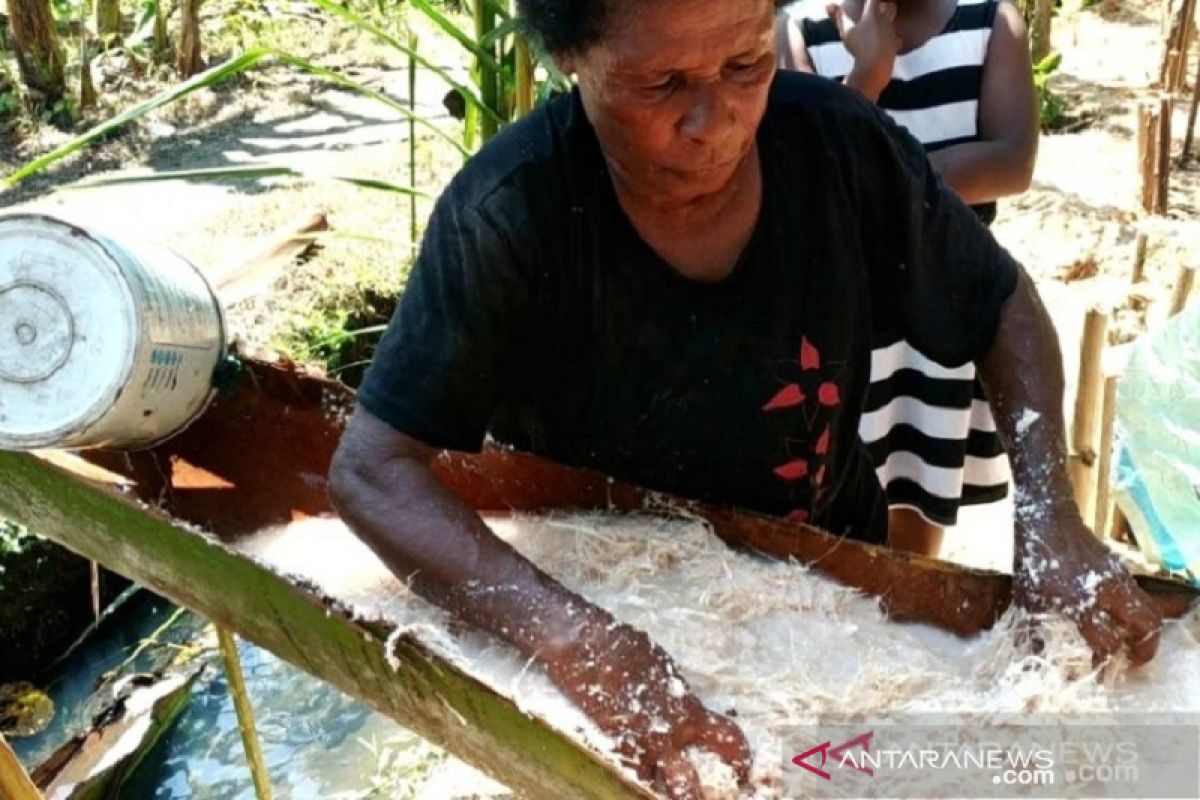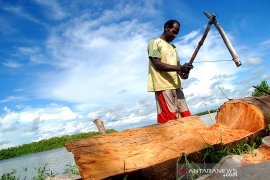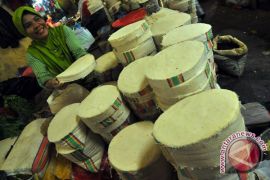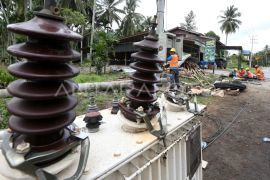The indigenous Papuans are already familiar with and are used to consuming sago, and even though we are still in the middle of the COVID-19 pandemic, this local food is still in demand by indigenous PapuansJakarta (ANTARA) - Sago, a starch extracted from the centre or pith of tropical palm stems, particularly Metroxylon sagu, has traditionally been a major staple food in Papua.
Sago starch obtained from local starch-producing plants from the Arecaceae family is commonly processed into several types of foods consumed by the people of Papua.
Traditional sago food products in Papua include papeda, plate sago, buburnee, sago Tutupala, sago uha, sinoli, and bagea.
But lately, sago has been losing its prime place in kitchens in the eastern Indonesian province.
Mama Ike, a sago seller at the Hamadi Jayapura market in Papua, said the only buyers she receives nowadays belong to the indigenous Papuan communities.
"The indigenous Papuans are already familiar with and are used to consuming sago, and even though we are still in the middle of the COVID-19 pandemic, this local food is still in demand by indigenous Papuans," she elaborated.
The price of authentic Papuan sago in the market is quite reasonable at around Rp20 thousand (around US$1.43) for a package containing half a kilogram of sago starch, she informed.
"Now, I do not sell much of sago starch everyday at Hamadi market in Jayapura City because the buyers are indigenous people who need it, and they are usually from outside the city of Jayapura," she said.
Unlike the indigenous communities, most Papuans nowadays only use sago as an alternative to rice. People in Papua are consuming sago rarely and it has become increasingly less popular than rice.
However, this has created a problem: Not all areas in Papua are suitable for rice planting. As a result, Papua has to obtain rice from outside to meet local demand.
For this reason, the local Papuan government, in accordance with Governor Lukas Enembe's policy of developing Papua based on local potential and wisdom, is seeking to encourage the sustainability of sago starch consumption, which has long been a local staple.
Food security
Sago has great potential as a substitute for rice, and this can help Indonesians, especially those residing in the eastern regions, to build food security.
This is also in line with the food security program which the government has been promoting of late.
The prospect of sago utilization for building food security in Papua is very promising, according to observers.
The reason for this lies in the ability of the sago plant to grow well in marshes and in environments with high or low water tide, where other carbohydrate-producing crops are difficult to grow.
The agronomic requirements of the sago plant are simpler than other carbohydrate-producing crops and its harvesting also does not depend on a particular season.
In addition, sago trees can be easily found in many parts of eastern Indonesia as they still grow wild in several regions, including Papua.
Sago plants (Metroxylon sago Rottb.) are widespread in a number of areas in Papua.
The total area under sago plantation across the world is estimated to be around 2.2 million hectares, of which 1.128 million hectares are in Indonesia alone. Such an acreage is equivalent to production of 7.89 to 12.97 million tons of dry sago starch per year.
The method of processing sago palm extracts into sago starch has been carried out by indigenous Papuans traditionally.
Sago starch can be processed into glucose syrup, fructose syrup, and sorbitol, among other things.
Sago can also be processed into more commercial foods, such as breads, biscuits, noodles, vermicelli, crackers, some sago starch-based Indonesian traditional cakes, and so on.
In the modern food industry, sago flour has often been used as a thickener to add texture to cakes and snacks.
Head of the Department of Industry, Trade, Cooperatives, Small and Medium Enterprises and Manpower in Papua, Omah Luhani Ladamay, has expressed the hope that sago will not only continue to be a Papuan staple, but also be used in the food and beverage business in the near future.
"At the sago week exhibition in Jakarta, Papua province got an Indonesian Museum of Records (MURI) award. I think it is an evidence of the potential of sago -- whose amount is so abundant in Papua -- to be able to provide economic benefits for indigenous Papuans," he remarked.
Furthermore, in terms of nutritional content, sago contains a lot of carbohydrates besides some protein, vitamins, and minerals, he pointed out.
A hundred grams of dry sago starch contains 94 grams of carbohydrates, 0.2 grams of protein, 0.5 grams of fiber, 10 mg of calcium, and 1.2 mg of iron. About 100 grams of sago starch have 355 calories.
Therefore, sago is a known source of energy and stamina, especially for carrying out physical activity.
Of all the advantages of sago, it is evident that it can be a key for diversifying diets and ensuring food safety and security in Indonesia.
For this reason, various studies have been carried out by the Ministry of Agriculture through the Agricultural Technology Research Center (BPTP) in Papua, which aims to re-promote, conserve, and cultivate sago in the region.
Dr. Alberth Soplanit, who is researching the cultivation of local Papuan food plants, said the BPTP team in Papua has collected sago seedlings for agronomic studies to see which nursery methods are the most suitable for specific land conditions for sago growth.
It is hoped that the efforts to re-develop sago cultivation in Papua will not only serve as a solution for local residents to meet their food needs, but also a concrete measure of the government's support in protecting sago plants as the local staple of indigenous Papuans, he said. (INE)
Related news: Indonesia enters 2021 with "abnormal" natural disasters
Related news: Preserving Indonesia's mangroves crucial for climate change mitigation
Editor: Fardah Assegaf
Copyright © ANTARA 2021












